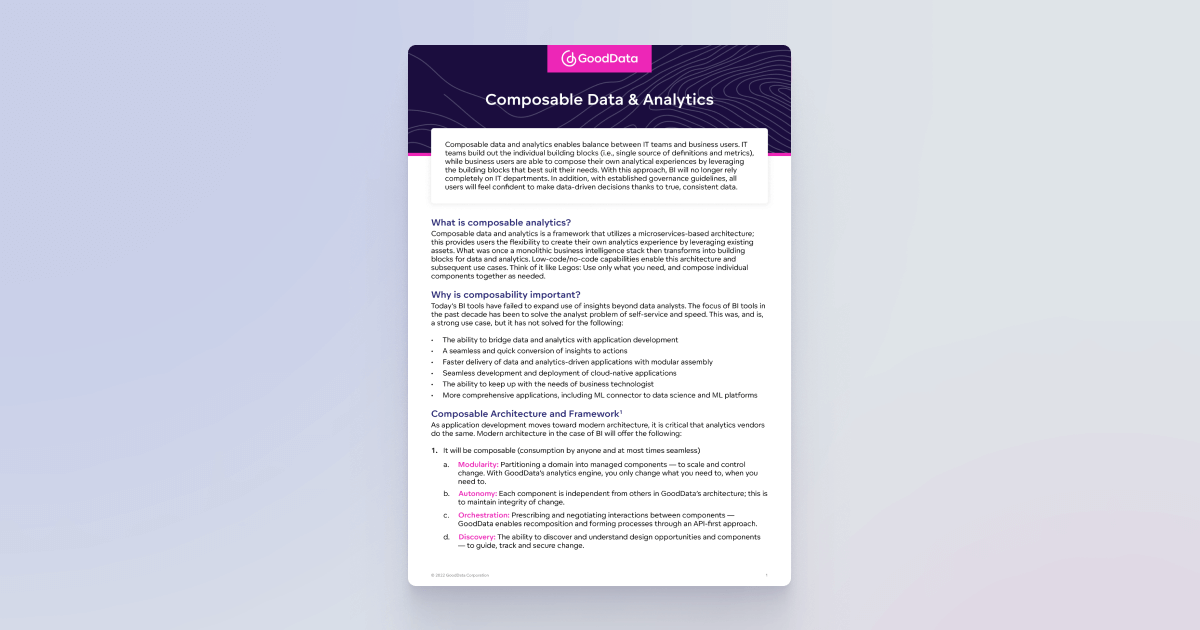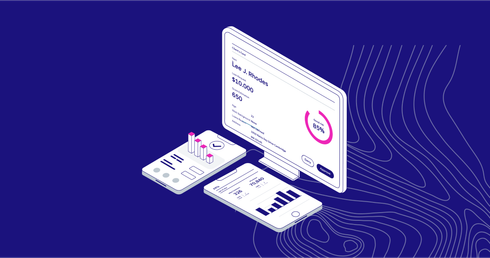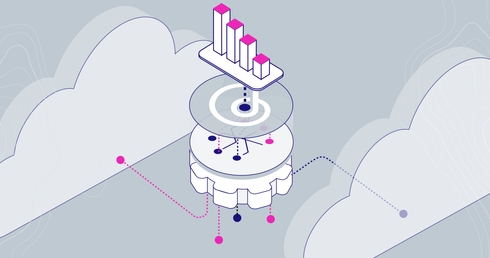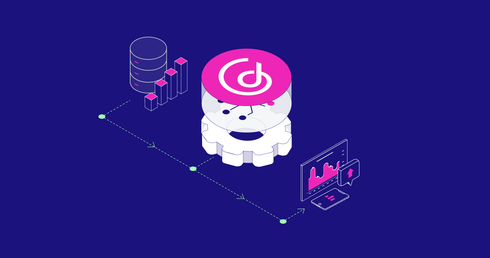Composable data and analytics enables balance between IT teams and business users. IT teams build out the individual building blocks (i.e., single source of definitions and metrics), while business users are able to compose their own analytical experiences by leveraging the building blocks that best suit their needs. With this approach, BI will no longer rely completely on IT departments. In addition, with established governance guidelines, all users will feel confident to make data-driven decisions thanks to true, consistent data.
What is composable analytics?
Composable data and analytics is a framework that utilizes a microservices-based architecture; this provides users the flexibility to create their own analytics experience by leveraging existing assets. What was once a monolithic business intelligence stack then transforms into building blocks for data and analytics. Low-code/no-code capabilities enable this architecture and subsequent use cases. Think of it like Legos: Use only what you need, and compose individual components together as needed.
Why is composability important?
Today’s BI tools have failed to expand use of insights beyond data analysts. The focus of BI tools in the past decade has been to solve the analyst problem of self-service and speed. This was, and is, a strong use case, but it has not solved for the following:
- The ability to bridge data and analytics with application development
- A seamless and quick conversion of insights to actions
- Faster delivery of data and analytics-driven applications with modular assembly
- Seamless development and deployment of cloud-native applications
- The ability to keep up with the needs of business technologist
- More comprehensive applications, including ML connector to data science and ML platforms
Composable Architecture and Framework
As application development moves toward modern architecture, it is critical that analytics vendors do the same. Modern architecture in the case of BI will offer the following:
1. It will be composable (consumption by anyone and at most times seamless)
- Modularity: Partitioning a domain into managed components — to scale and control change. With GoodData’s analytics engine, you only change what you need to, when you need to.
- Autonomy: Each component is independent from others in GoodData’s architecture; this is to maintain integrity of change.
- Orchestration: Prescribing and negotiating interactions between components — GoodData enables recomposition and forming processes through an API-first approach.
- Discovery: The ability to discover and understand design opportunities and components — to guide, track and secure change.
2. Data will be an asset and thus will be treated with formal SLAs and connected/active governance.
3. API-first.
4. Micro-services (mini best of breed singular applications).
GoodData Composable Data and Analytics
GoodData offers a composable data and analytics platform that creates business and IT alignment, breaking down data silos that erode trust and prevent collaboration. Composability gives more people access to insights, empowering even those who are not versed in SQL to customize and utilize data insights for business growth and innovation.
Gartner estimates that embracing this type of composable approach will expand adoption of analytics to an additional 41% of a company — bringing business and corporate departments into the fold: “Gartner research says, on average, 41% of employees outside of IT — or business technologists — customize or build data or technology solutions.
Gartner predicts that half of all new low-code clients will come from business buyers that are outside the IT organization by year-end 2025, too.” (Gartner Press Release, “Gartner Forecasts Worldwide Low-Code Development Technologies to Grow 23% in 2021,” February 16, 2021)
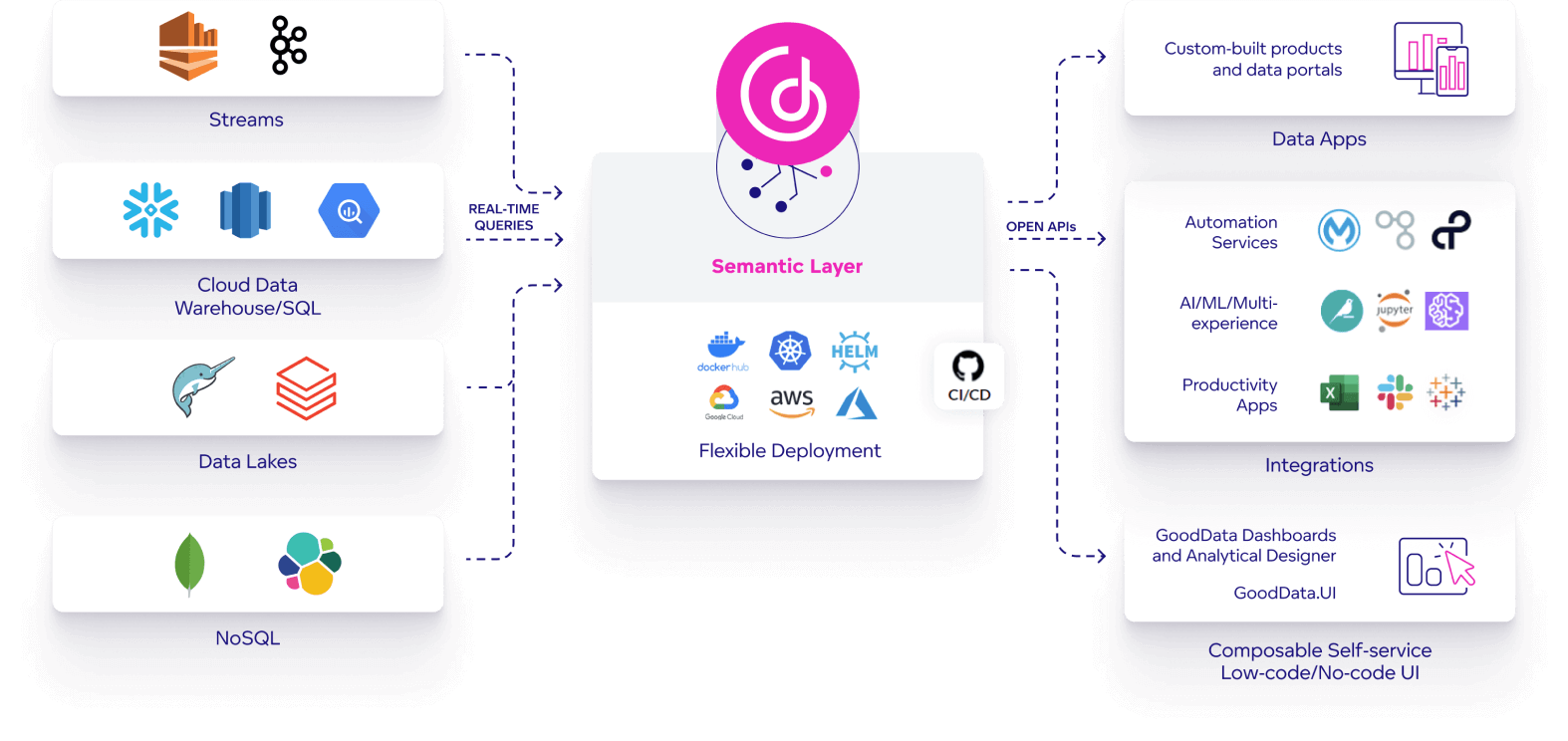
GoodData Architecture
GoodData is a multi-tenant, composable data and analytics platform that can be run in a public or private cloud, allowing you to build rich analytics for your end users. At a high level, this platform provides easy-to-use visual analytics tools, embeddable data visualization, and application integration. The platform also provides a robust end-to-end pipeline, including data ingestion, preparation, and transformations. Our composable architecture allows businesses to seamlessly integrate with existing infrastructure and easily implement analytics solutions for employees, customers, or business partners.
Headless BI Engine
Headless BI is a key part of GoodData’s analytics platform: it’s built to scale with containerized microservices, managed as a code, and separates analytical calculations from the consumption layer. You can connect any application, data platform, or visualization tool to the engine’s semantic layer — via APIs and standard interfaces — and consume the same consistent analytics in real time, anywhere.
Semantic Layer
The GoodData semantic layer ensures that all of your end users, including self-service users, understand the data in the same way. The information in the semantic model can be leveraged for enterprise analytics and provides a shared understanding of the analyzed entities and their relationships. This means that objects, which are created by analysts once, can be used multiple times by other common users, helping them to interpret the data and perform ad-hoc data discovery. This concept allows users to retrieve valuable insights from their data, no matter their level of data literacy.
APIs
The GoodData platform includes a rich set of APIs and SDKs that create a flexible environment for developers to build and extend the platform to meet the customized needs of the business. All platform capabilities available through the user interface can also be invoked via a REST API. GoodData provides convenient SDKs for accessing the platform functionality, from multiple programming languages. The GoodData platform also utilizes numerous open standards interfaces and protocols (i.e., JDBC). This open standards approach allows developers to use their tools of choice to develop and deploy specific backend or frontend components to their GoodData platform solutions.
Workflow Examples
Here are examples on how business users can create without limited or no help from IT.
Analyst for Investment Firm
- Builds custom dashboards to share insights with investors so they can access and make decisions about making changes to their portfolio in real time.
Delivery Manager
- Leverages data from multiple sources on traffic patterns to optimize delivery routes, then creates a dashboard for employees to access and utilize without asking for any additional technical help.
Manager at Staffing Agency
- Reviews month-over-month and year-over-year trends on how many positions they were able to fill for each client and shares with their team without leaving Slack or Google Chrome.
Hospital Manager
- Builds custom dashboards to compare hospitalization trends across facilities in the same region to predict future hospitalizations during the pandemic, without requesting for IT help.
Retail Store Manager
- Incorporates best practices in identifying best- and worst-selling products by pulling different data points together in a dashboard that was previously built by upper management.
Continue Reading This Article
Enjoy this article as well as all of our content.
Does GoodData look like the better fit?
Get a demo now and see for yourself. It’s commitment-free.
